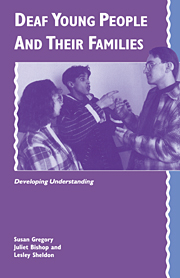Book contents
- Frontmatter
- Contents
- Preface
- Acknowledgements
- 1 The young deaf people and their families
- 2 Family life and communication
- 3 Experiences of education
- 4 The world of work
- 5 Deaf young people in a hearing world
- 6 Friendships, relationships and social life
- 7 Being deaf
- 8 The family and the young deaf person
- 9 Reflections
- References
- Appendices
- Index
1 - The young deaf people and their families
Published online by Cambridge University Press: 26 March 2010
- Frontmatter
- Contents
- Preface
- Acknowledgements
- 1 The young deaf people and their families
- 2 Family life and communication
- 3 Experiences of education
- 4 The world of work
- 5 Deaf young people in a hearing world
- 6 Friendships, relationships and social life
- 7 Being deaf
- 8 The family and the young deaf person
- 9 Reflections
- References
- Appendices
- Index
Summary
I want hearing people to learn about deaf people
IsabelIn your wildest dreams you cannot imagine the way I feel
Isabel's motherIsabel is an articulate young deaf person. She has a good command of English, though not everyone could understand her speech. She uses English with her parents and hearing friends, and sign language with her deaf friends. In an interview, she described how she signed in her dreams and explained ‘It's something to do with having a signing mind’. When she was young she thought that when she grew up she would be hearing as all the adults she knew could hear. She and her deaf friends used to discuss this at school, looking forward to the time when they would talk as quickly and easily as their parents did. However, by the time she was seven or eight years old, she realised she would always be deaf. She was always educated alongside other deaf pupils but she felt it was worse for her deaf boy friend who went to a school with all hearing pupils, as he was very lonely and thought he was ‘the only deaf person in the world.’
As an adult, Isabel explained ‘I am happy to be deaf’, though she also added that if there was an operation that was successful in restoring hearing she would consider it. She described her relationship with her boyfriend as ‘beautiful’ as they cared for and helped each other.
- Type
- Chapter
- Information
- Deaf Young People and their FamiliesDeveloping Understanding, pp. 1 - 27Publisher: Cambridge University PressPrint publication year: 1995
- 5
- Cited by



